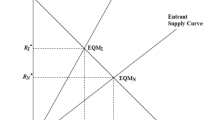Abstract
We present a cost model for splitting Internet dial-up traffic (which varies by time-of-day) between two large modem banks. One of the modem banks charges by the hour, the other charges for the peak number-in-system during the day. To study if the possible savings are enough to make the effort worthwhile, we formulate a clairvoyant (“perfect information”) Integer Program that is equivalent to a network flow problem. This leads us to use a ceiling policy. In the stochastic control case, we use a Modified Offered Load (MOL) approximation to explore the properties of the system, and develop a square-root-type rule to set the ceiling in the homogeneous case. We also use simulation to determine an optimal ceiling when we cannot route individual calls precisely. We propose approximations that may be computed for any call duration distribution, and compare their answers to exact differential-equation procedures for Exponential call durations.
Similar content being viewed by others
References
R.K. Ahuja, T.L. Magnanti and J.B. Orlin, Network Flows: Theory, Algorithms, and Applications, (Prentice-Hall, 1993).
S.G. Eick, W.A. Massey and W. Whitt, M t /G/∞ queues with sinusoidal arrival rates, Management Science 39(2) (1993) 241–252.
S.G. Eick, W.A. Massey and W. Whitt, The physics of the M t /G/∞ queue, Operations Research 41(4) (1993) 731–742.
L.V. Green, P.J. Kolesar and A. Svoronos, Some effects of nonstationarity on multiserver Markovian queueing systems, Operations Research 39(3) (1991) 502–511.
P.J. Kolesar and L.V. Green, Insights on service system design from a normal approximation to Erlang's formula, Production and Operations Management 7(3) (1998) 282–293.
W.A. Massey and W. Whitt, An analysis of the modified offered-load approximation for the nonstationary Erlang loss model, Annals of Applied Probability 4(4) (1994) 1145–1160.
C. Palm, Intensity Variations in Telephone Traffic (translation of 1943 article in Ericcson Technics, 44, 1-189) (North-Holland, Amsterdam, 1988).
S.M. Ross, Average delay in queues with non-stationary Poisson arrivals, J. Appl. Prob. 15(3) (1978) 602–609.
S.M. Ross, Introduction to Probability Models, 8th edn, (Academic Press, 2003).
R.A. Vitale, Some comparisons for Gaussian processes, Proceedings of the American Math. Society 128(10) (2000) 3043–3046.
Author information
Authors and Affiliations
Corresponding author
Additional information
AMS subject classification: 60K25, 90B18, 68M20, 90B22, 60K30
Rights and permissions
About this article
Cite this article
Ross, A.M., Shanthikumar, J.G. Dial-Up Internet Access: A Two-Provider Cost Model. Queueing Syst 51, 5–27 (2005). https://doi.org/10.1007/s11134-005-1671-2
Received:
Revised:
Issue Date:
DOI: https://doi.org/10.1007/s11134-005-1671-2




